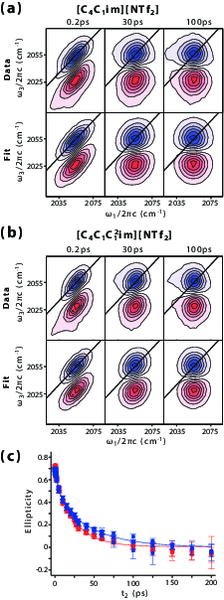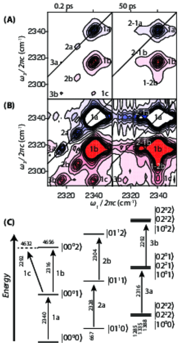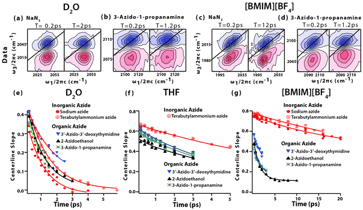Reports: DNI653936-DNI6: Ultrafast Vibrational Spectroscopy (2D-IR) of Ionic Liquids
Sean Garrett-Roe, PhD, University of Pittsburgh
Ionic liquids are salts that are molten at room temperature. They are liquids composed of cations and anions with no excess solvent. Ionic liquids are fascinating from both the practical and fundamental points of view. Their low vapor pressure, high thermal stability, and chemical tunability make them “green solvents” whose properties can be tuned for the application at hand. For example, these solvents show promise for natural gas sweetening, reaction media, non-aqueous electrolytes, and carbon capture absorbents.
More than 1018 ionic liquids are possible, only the smallest fraction of which have been tested. What is missing is the fundmental understanding to guide the exploration of this large chemical space. The competition between intermolecular forces – electrostatic attraction, dispersion, polarization, and hydrogen bonding – makes the bulk properties of these fluids difficult to predict from their molecular properties. In the same way that solvation structure and dynamics dictate the behavior of simple liquids, so do they control the properties of this class of complex liquids.
To develop a deeper understanding of the molecular interactions in these complex solvents, we use ultrafast vibrational spectroscopy (2D-IR) to elucidate local structure and dynamics. Ultrafast spectroscopy has the time resolution to resolve intermolecular motions. Vibrational spectroscopy has the advantage of small, well-defined chromophores which can provide local chemical information. A comprehensive understanding of how molecular structure of the ionic liquid's components dictates the solvation dynamics will lead to the insights needed for the rational design and optimization of ionic liquids for many important applications, from supercapacitors, to carbon capture absorbents, to catalysis.
A. Solvation dynamics
Viscosity is a key property to optimize for many applications of ionic liquids. This thrust of our work has several new and significant physical insights.
The fundamental rate limiting step for the onset of diffusive motion is the breaking of local ion cages.} This is a new framework in which to understand the controversial relationship between hydrogen bonding patterns and viscosity.
Water and small counter-cations can induce dynamical heterogeneity. These experiments have supported or view that SCN- is a local probe because we see the development of heterogeneous dynamics induced by varying the amount of water in the ionic liquid, by changing the SCN-'s counter-ion, and by changing the SCN- concentration. That is, different molecules in different chemical environments have different dynamics.
B. Carbon capture from carbon dioxide's point of view
There is a pressing need to develop next-generation materials to capture CO2 from natural gas sources to make future natural gas fields economically viable. Commercial carbon capture technologies are inefficient and require substantial energy inputs. Novel materials, including metal-organic frameworks, polymers, and ionic liquids, have been proposed as transformational technologies. In each case, however, a lack of tools to interrogate at a molecular scale how CO2 interacts with the sorbents, what local structures it forms, and for how long those structures persist has limited the ability to optimize these materials for this important task.
Our strategy to investigate the local environment of CO2 is to use a vibration of the CO2 itself. We hypothesized that the antisymmetric stretching vibration of CO2, the nu3 mode, could be a sensitive probe of the carbon capture process and that ultrafast two-dimensional vibrational spectroscopy (2D-IR) could give new insight into the local structure and dynamics around the CO2. Our work has several new and significant physical insights.
In ionic liquids, the antisymmetric stretch of CO2, the nu3 mode, is a bright and information rich vibrational chromophore for multidimensional spectroscopy. We observe spectral diffusion on a tens of picoseconds timescale, ranging from 12—100 ps as a function of the ionic liquid's anion. We propose a picture in which the timescale of spectral diffusion is gated by the motion of the anion. Based on this picture, we show that the dynamics for CO2 as well as other vibrational chromophores (e.g. SCN- and HOD) follow a linear scaling with ionic liquid viscosity. This part of the work is important because it establishes a new tool to give detailed molecular information -- on the one hand this will be interesting to the synthetic chemists who are designing new ionic liquids for carbon capture, and, on the other, to the computation chemists who are designing new models to simulate ionic liquids.
We clarify the origin of a shoulder in the IR spectrum as thermal excitation of the bend vibration, the nu2 mode, which is anharmonically coupled to the nu3 mode. We observe dynamic cross-peaks in our 2D-IR spectra, which we are able to model quantitatively as the excitation and de-excitation of these bending quanta at equilibrium. To our knowledge, this is the first time this mechanism for dynamical cross-peaks has been observed.
Ionic liquid mixtures can enable enhanced CO2 diffusion and higher conductivities to due increased cation mobility. This work demonstrates that mixing available ionic liquids is a cheap alternative to custom synthesis in optimizing the properties of ionic liquids (Collaboration with H. Nulwala NETL).
C. Reactive species in ionic liquid: Organic and inorganic azides partition differently
We have investigated azides, which are important for their cycloaddition reactions, in order to understand how the ionic liquid environment influences their reactivity. We tested the hypothesis that the polar and non-polar regions of ionic liquids could cause organic and inorganic azides to partition differently. The work has new physical insights.
Ionic liquids solvate organic and inorganic azides differently. The dynamics of N3- and R-N3 are markedly different in imidazolium ionic liquids. N3- is incorporated in the network of charges, which rearranges more slowly, while the organic azide is pi-bonded to the imidazolium aromatic ring, effectively outside of the charge network even when the ionic liquid does not have a distinct non-polar domain. This work provides molecular insight into the different reaction rates observed in these types of ionic liquids.














